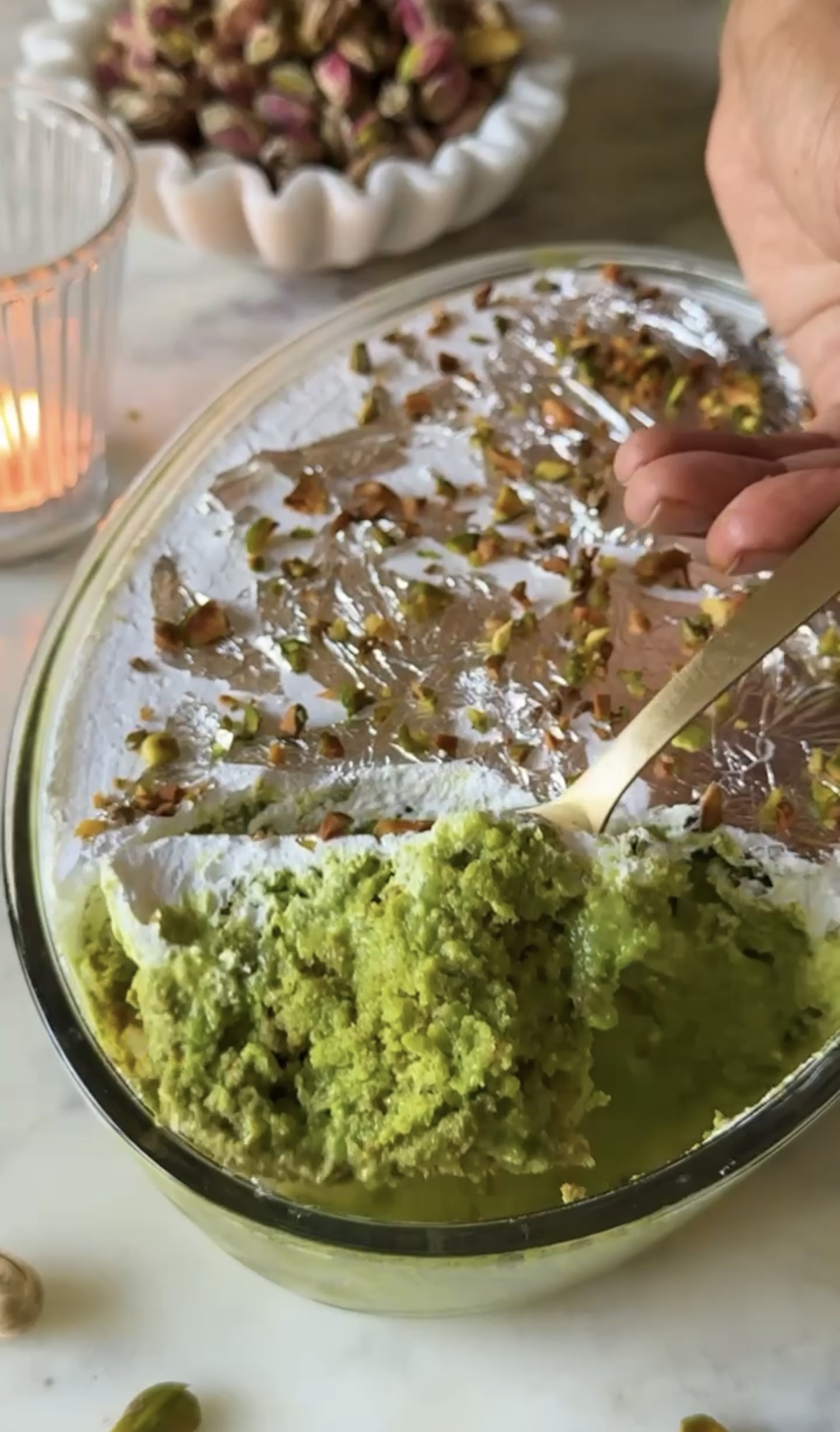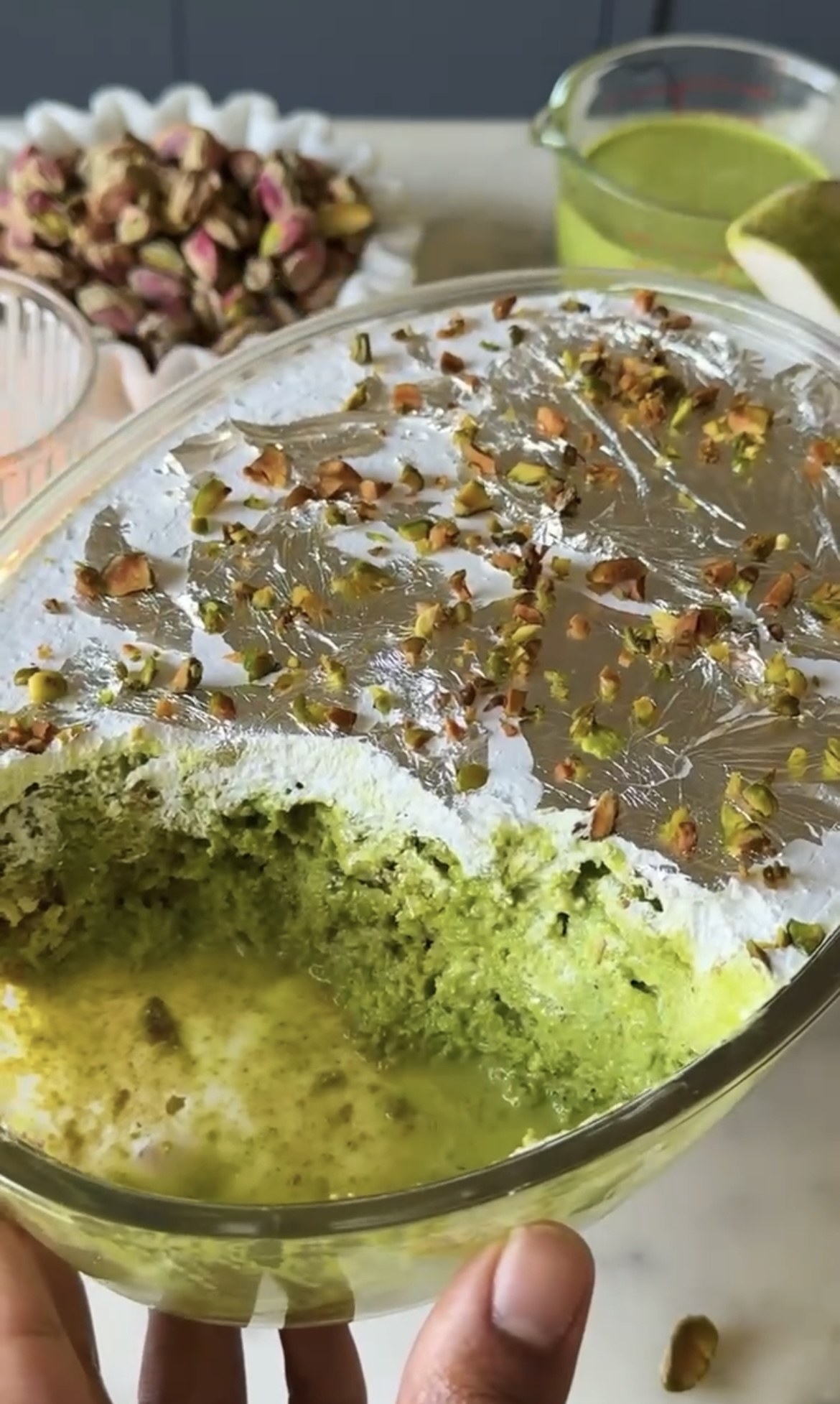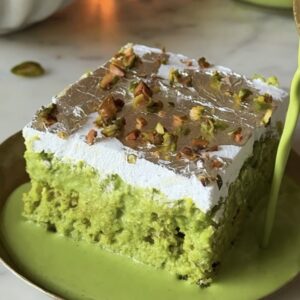Eggless Pistachio Milk Cake is one of those desserts that feels extra special every time I make it. The simple base of a soft milk-soaked sponge transforms into something rich and creamy, while the pistachios add just the right amount of crunch and flavor. It’s not overly complicated, but the way the sweet milk seeps into the cake makes it taste luxurious. The pistachios on top give it a beautiful, nutty touch that balances out the sweetness perfectly. It’s a go-to dessert when I want something both comforting and elegant, especially for family gatherings or when I just feel like treating myself.

WHAT YOU’LL LOVE ABOUT THIS
- Eggless
- Showstopper dessert
- Rich pistachio flavour
- Easy to make

INGREDIENTS USED IN PISTACHIO MILK CAKE
SUGAR
The most obvious reason is that sugar adds sweetness to the cake, making it enjoyable and satisfying to eat. Sugar helps keep the cake moist, preventing it from becoming dry and crumbly during the cooking process. I have used castor sugar for this recipe.
OIL
Oil adds tenderness to the cake’s crumb. Oil coats the flour particles and interferes with gluten formation, resulting in a more delicate and less chewy texture. It is often easier to mix into cake batters compared to solid fats like butter. It can be blended more uniformly with other ingredients, ensuring an even distribution of fats throughout the batter.
MILK
Milk helps dilute the batter to achieve the desired consistency. This makes the batter easier to work with and results in a smoother texture. In recipes that use baking powder as a leavening agent, milk can react with it to produce carbon dioxide gas. This gas creates air bubbles within the batter, causing the cake to rise and become fluffy. I have used Nestle Milk for this recipe.
ALL-PURPOSE FLOUR
Flour helps absorb the moisture from other ingredients in the batter, which contributes to the cake’s texture and prevents it from being overly wet. It interacts with leavening agents like baking powder and baking soda to create gas (usually carbon dioxide) that causes the cake to rise. Flour is a primary structural ingredient in cakes. It provides the framework for the cake’s crumb and gives it a cohesive texture. It also produces a tender crumb in the cake.
LEAVENING AGENTS
Baking powder and baking soda are used in this cake recipe as raising agents. Leavening agents introduce gas bubbles into the cake batter. When heated in the microwave, these bubbles expand, causing the cake to rise and become airy. The rise from leavening agents helps the cake cook more evenly in the microwave, ensuring that the center and edges of the cake cook at a similar rate.
PISTACHIOS
In Pistachio Milk Cake, pistachios are the star that elevate the entire dessert. Their nutty, slightly sweet flavor cuts through the richness of the milk-soaked sponge, providing a perfect balance between creamy and crunchy. Sprinkled generously on top, the finely chopped pistachios add not only flavor but also texture, offering a satisfying bite against the soft, melt-in-your-mouth cake. Beyond taste, they give the cake a touch of elegance with their vibrant green color, making it look as indulgent as it tastes. Whether mixed into the batter or used as a garnish, pistachios bring a layer of depth to the cake, making each bite more delightful and special.

EQUIPMENTS USED FOR PISTACHIO MILK CAKE
To mix all my ingredients together, I’m using Borosil’s 100% Borosilicate Glass Bowl which is microwave and oven safe, plus the bowls are super easy to clean and handle, which makes my baking process totally hassle free!
Not a single day goes in my kitchen when I don’t use my set of Measuring Cups and Measuring Spoons.
Spatula and whisk to bring the batter together.
A blender jar will also be required to make the milk soak.

OTHER SIMILAR RECIPES ON THE BLOG

TIPS TO MAKE PISTACHIO MILK CAKE
- Ensure that the pistachios are fresh and unsalted for the best flavor.
- Make sure the cake sponge is light and airy, as it needs to absorb the milk mixture well. A soft sponge will give the cake its signature melt-in-the-mouth texture.
- When pouring the milk mixture over the cake, be generous. Let the cake rest for at least a few hours to fully absorb the liquid for the best texture.
- Refrigerate the cake after soaking it in the milk mixture. This allows the cake to firm up slightly and enhances the flavor of the pistachios and milk.
- For a smooth bite with the right amount of crunch, finely chop or crush the pistachios. Sprinkle them on top of the cake for a beautiful presentation and flavor.
- Add a layer of lightly sweetened whipped cream on top before garnishing with pistachios to add extra richness and creaminess.
- For an extra layer of flavor, you can add a pinch of cardamom or rose water to the milk mixture or whipped cream, which pairs wonderfully with pistachios.
- ½ cup sugar
- 6tbsp oil
- 6tbsp yogurt
- 10 tbsp milk
- 1+1/2 cup flour
- ½ cup pistachios
- 1 tsp baking powder
- ½ tsp baking soda
- For the soak
- ½ cup pistachios
- ½ cup condensed milk
- 1+1/2 cup milk
- Preheat the oven to 180 degrees Celsius.
- In a bowl add sugar, oil, yogurt and milk. Give it a good whisk till sugar is dissolved and everything is combined
- Then add flour, ground pistachios, baking powder and baking soda. Give it a good whisk till everything is combined and you achieve a smooth batter.
- Transfer this batter into a baking dish and bake for 35-40 mins or till the skewer inserted in the centre comes out clean.
- Meanwhile, make the soak by blending pistachios and condensed milk together till you achieve a paste like consistency.
- Add in the milk in pistachio paste and the soak is ready.
- Poke the baked cake using a skewer while it is still hot and pour the soak mixture all over it.
- Once the cake has soaked the liquid, refrigerate for about 1 hour .
- Garnish with whipped cream, silver foil and chopped pistachios.
If you like my pistachio milk cake recipe and happen to make them in your kitchen, do tag me on Instagram and share pictures with me using #Bakewithshivesh. Happy Baking!


 Hello. I'm Shivesh Bhatia, a food blogger and food stylist from Delhi, India. Welcome to Bake With Shivesh, where I'll help you create magic in your kitchens with my simple recipes.
Hello. I'm Shivesh Bhatia, a food blogger and food stylist from Delhi, India. Welcome to Bake With Shivesh, where I'll help you create magic in your kitchens with my simple recipes.
Leave a Reply